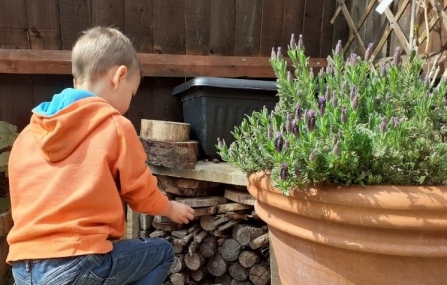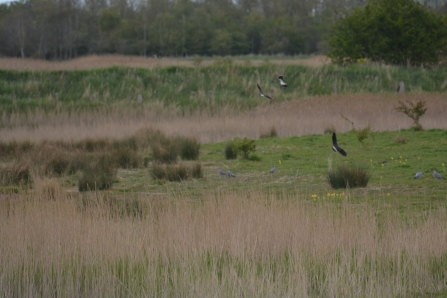I have spent time working from home when possible during this challenging and difficult period. A much-needed connection with nature has at times been limited to my garden. Observing spring bird migration as swallows fly over, listening to bird song from the small copse behind the house, searching for insects in the undergrowth and finally getting around to constructing a bug hotel with the kids!
A return to work and to nature
A meadow pipit perched on the Croft Marsh fencing shortly after carrying out a parachuting flight descent whilst singing.

A keen young wildlife gardener hard at work (Jim Shaw)
Although I’ve enjoyed discovering and taking a closer look at the wildlife at home, essential livestock related work has made it possible for me to re-connect with the great outdoors and get back out on the reserves.
Having access restricted to these incredible wild places that I am often exposed to has made me realize just how much I rely on nature for my own physical and mental health and well-being. I believe that we all deserve to live in a healthy wildlife-rich world and experience a regular connection with nature.
I believe that we all deserve to live in a healthy wildlife-rich world and experience a regular connection with nature.
As Assistant Warden at Gibraltar Point livestock management is a big part of my job, grazing can maintain and enhance our grasslands for wildlife and retain their biodiversity. Grazing of cattle, sheep and ponies is a vital element of the management of Lincolnshire Wildlife Trust nature reserves, also making it possible to support local graziers and the farming community.
After working at home for two weeks, I recently returned to work at Gibraltar Point to repair fencing on our wet grassland in preparation for the arrival of cattle. I was instantly uplifted during my return to this incredible reserve and I thought I would share some of the fantastic experiences that continue to motivate me to work to protect wildlife.
The sound of redshank, lapwing, skylarks and meadow pipits were singing during their flight displays - all target breeding species of conservation concern, these are ground-nesting birds that need a varied sward condition and a grassland mosaic that is maintained by low-intensity cattle grazing.
Lapwing on Croft Marsh, they nest is a small scrape on the ground lined with plant material.

Lapwings carried out flight displays over Jacksons Marsh, a male bird rolls and dives in flight whilst calling to advertise his presence to females, making a distinctive ‘peewit’ sound.
A meadow pipit perched on the Croft Marsh fencing shortly after carrying out a parachuting flight descent whilst singing.
As if the local breeding birds weren’t enough to lift my spirits, sedge warblers were singing from the nearby ditches and scrub, a cuckoo was calling in the distance (a nest parasite probably looking to lay its eggs in the meadow pipit nests!), blackcaps and chiffchaffs were singing from the nearby plantation woodland – all signs of the exciting Spring ahead as our long-distance migrant birds arrive to set up breeding territories.
An inquisitive brown hare appeared from nowhere and was within several meters. Its these kinds of sightings that ensure I always have a camera to hand!
A brown hare appeared eager to observe the straining of some stock fencing, I wonder what happened to that ear?
Brown hares are frequently seen on the Gibraltar Point grazing marsh, the wet grassland provides the ideal habitat where they eat grasses and wildflowers.
My first swift of the year flew over high, over 50 swallows and several house martins were aerial feeding on invertebrates over the marsh. I could hear yellow wagtails calling, and then several birds dropped in at close range to forage for invertebrates on the ground.
Yellow wagtail, the bright plumage and variation within this species makes every bird a pleasure to observe.
Up to 7 wheatears dropped in around me, its amazing to think that just a few weeks ago these birds were in tropical Africa!
Wheatears perched on the fence posts behind the tractor trailer.
A male wheatear hopping and running amongst the cowslips
I am extremely grateful for the huge support from our valued members, supporters and volunteers, all of which help to protect the wonderful wild places that we are lucky enough to have in Lincolnshire.

